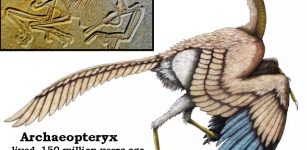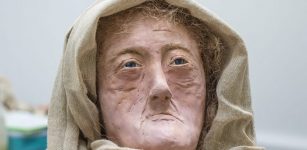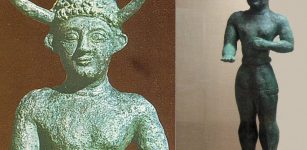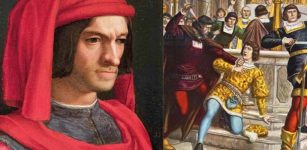Jure Grando – First ‘Real’ Historical Vampire Case Documented
Jan Bartek - AncientPages.com - Today, many watch movies and read books about vampires because these are entertaining stories. Most people do not believe in real vampires, but ancient people were convinced these scary blood-sucking creatures did exist, and they were extremely dangerous.
Accounts of vampires occur in mythology and folklore worldwide. Perhaps the most famous vampire is Bram Stoker's Dracula, whose renowned book has been made into a movie.
Credit: Adobe Stock -captblack76
Vampires In Mythology, Movies, And Books
"Dracula did, in fact exist. However, he was not a bloodthirsty vampire but a Prince in Wallachia, a part of present-day southern Romania.
His real name was Vlad III, but he was often called Dracula. Romania is full of ancient tales of the supernatural and legends of the unexplained, and these stories have long influenced our imagination.
The Irish author Bram Stoker likely borrowed Vlad's name for his Transylvanian count in the book "Dracula" in 1897. We have to remember that 'Dracula' is literally translated in Gaelic as Drac Ullah, which means 'bad blood'.
Vlad lived between 1431 and 1476 and is regarded as a national hero in his home country. He was considered a brutal and yet fair ruler." 1
Vampires are frequently encountered in mythological stories. "Vetala that we face in Hindu mythology is the closest we can come to the Western definition of a vampire,
Being an evil spirit, vetala lurks in burial grounds, haunts cemeteries, and takes demonic possession of corpses. Like many like the Indian night stalkers, vetala "delights in killing children, causing miscarriages, and driving people mad." 2
Compared to other vampires, Vetala is unusual because this frightening creature also possesses knowledge of the past, present, and future.
"Myths and legends of Europe, both Americas, China, Japan, and India describe terrible bloodsuckers that may differ in their power and individual characteristics, but all of them fascinate people, and their vampiric fright knows no borders.
Powerful legends about Jiangshi (or Jiang shi) have long inspired a genre of literature, movies, and video games, especially in Hong Kong and East Asia.
Jiangshi - a truly terrifying undead Chinese creature - is described in Chinese legends and folklore as a half-vampire, half-zombie." 3
"In Colombian folklore, the Patasola ('La Patasola') is a female monster living on the summits of the plain. She has only one leg but can move with amazing speed.
People claim to have seen her jumping on one leg, through saws, ravines and roads, screaming mournfully. It is the soul in pain of the unfaithful woman who roams mountains, valleys and plains, who dishonored her children and failed to respect her husband." 4
The female vampire Patasola hates men. Using her supernatural powers, she disguised herself as a beautiful woman and chased her victims.
One could easily make the list of ancient vampires long, but it is enough to say stories of these blood-sucking beings have been told by many people in various countries.
"Early vampire accounts in Medieval and European folklore appear in the chronicles of 12-century English historians Walter Map and William of Newburgh, though the vampire proper did not appear until the 17 and 18 centuries. The first account of a real person being described as a vampire occurred in the region of Istria in modern Croatia in 1672.
Jure Grando of the village Khring near Tinjan was reported to be a vampire who caused panic among the villagers. Jure had died in 1656, but the villagers claimed he returned from the dead to drink human blood and sexually harass his widow. "5
Story Of Vampire Jure Grando Alilović
Legend tells Jure Grando Alilović or Giure Grando(1579–1656) rose from his grave every night for 16 years after his death. Every night, he went to the village and terrorized horrified people. Jure knocked on a door, and on whichever door he knocked, someone from that house would die within the next few days. People tried anything to kill him, but it seemed impossible.
Every night for 16 years, Jure Grando rose from his grave and terrorized people. Credit: Adobe Stock - Lucianus
"The village leader ordered that he be staked through the heart, but that didn't kill him, and subsequently the leader gave the order that he be beheaded, which proved more effective." 5
Jure Grando is considered the first "real" historical vampire because his case has been thoroughly documented. Johann Weikhard von Valvasor (1641 – 1693), a natural historian and polymath from Carniola, present-day Slovenia, and a fellow of the Royal Society in London, described Jure Grando's life in his encyclopedia The Glory of the Duchy of Carniola. It was the first written document on vampires.
Updated on October 13, 2023
Written by Jan Bartek - AncientPages.com Staff Writer
Copyright © AncientPages.com All rights reserved. This material may not be published, broadcast, rewritten or redistributed in whole or part without the express written permission of AncientPages.com
Expand for references- Sutherland - Dracula: Cruel, Ruthless And Bloodthirsty Ruler But Not A Vampire, AncientPages.com
- Ellen Lloyd - Vetala – Vampire With Knowledge Of The Past, Present And Future In Hindu Mythology, AncientPages.com
- Sutherland - Jiangshi – Terrifying Vicious Ancient Chinese Vampire In Disguise, AncientPages.com
- Sutherland - Patasola: Hideous One-Legged Female Vampire Who Kills Driven By Hatred In Colombian Folklore, AncientPages.com
- Hourly History - Vlad the Impaler: A Life From Beginning to End
- Wikipedia
More From Ancient Pages
-
 Oldest Recently Discovered Fossil of Bird ‘Archaeopteryx’ That Lived 150 Million Years Ago
Archaeology | Jan 29, 2018
Oldest Recently Discovered Fossil of Bird ‘Archaeopteryx’ That Lived 150 Million Years Ago
Archaeology | Jan 29, 2018 -
 Eclipse Was A Bad Omen, A Sign Of Gloom And Doom In Ancient Peoples’ Beliefs
Featured Stories | Sep 25, 2015
Eclipse Was A Bad Omen, A Sign Of Gloom And Doom In Ancient Peoples’ Beliefs
Featured Stories | Sep 25, 2015 -
 Face Of Iron Age Female Druid Reconstructed
Archaeology | Aug 20, 2019
Face Of Iron Age Female Druid Reconstructed
Archaeology | Aug 20, 2019 -
 Face Of Man From The Lost Medieval Village Of Dzwonowo Reconstructed Using 3D Printing Technology
Archaeology | Jul 20, 2020
Face Of Man From The Lost Medieval Village Of Dzwonowo Reconstructed Using 3D Printing Technology
Archaeology | Jul 20, 2020 -
 Truly Bizarre And Most Fearsome Ancient Helmets Ever Seen
Artifacts | Sep 1, 2016
Truly Bizarre And Most Fearsome Ancient Helmets Ever Seen
Artifacts | Sep 1, 2016 -
 Unusual Relic That Mysteriously Disappeared From The Vatican
Artifacts | Nov 8, 2018
Unusual Relic That Mysteriously Disappeared From The Vatican
Artifacts | Nov 8, 2018 -
 Eastern Necropolis Of Ancient Thracian And Roman City Of Serdica – Unearthed
Archaeology | Apr 10, 2017
Eastern Necropolis Of Ancient Thracian And Roman City Of Serdica – Unearthed
Archaeology | Apr 10, 2017 -
 Ancient Religious Ceremony May Shed Light On The Mysterious Qumran Site
Archaeology | Sep 6, 2021
Ancient Religious Ceremony May Shed Light On The Mysterious Qumran Site
Archaeology | Sep 6, 2021 -
 Old Kingdom Of Alashiya And City Of Enkomi With Roots On The Island Of Cyprus
Civilizations | Mar 1, 2018
Old Kingdom Of Alashiya And City Of Enkomi With Roots On The Island Of Cyprus
Civilizations | Mar 1, 2018 -
 Napoleonic Code: Why Was One Of The Most Influential Civil Codes Flawed?
Ancient History Facts | May 16, 2020
Napoleonic Code: Why Was One Of The Most Influential Civil Codes Flawed?
Ancient History Facts | May 16, 2020 -
 City Of Sais: Prehistoric Prestigious Cult Center Of Northern Egypt
Featured Stories | Oct 31, 2016
City Of Sais: Prehistoric Prestigious Cult Center Of Northern Egypt
Featured Stories | Oct 31, 2016 -
 Colossi Of Memnon: Gigantic Stone Statues Guarding The Temple Of Pharaoh Amenhotep III
Civilizations | Jul 13, 2016
Colossi Of Memnon: Gigantic Stone Statues Guarding The Temple Of Pharaoh Amenhotep III
Civilizations | Jul 13, 2016 -
 Unsolved Archaeological Mystery Of Ta Prohm Temple, Cambodia
Civilizations | Sep 3, 2018
Unsolved Archaeological Mystery Of Ta Prohm Temple, Cambodia
Civilizations | Sep 3, 2018 -
 Unraveling the mystery of the Rhynie Man
News | Aug 24, 2015
Unraveling the mystery of the Rhynie Man
News | Aug 24, 2015 -
 Pazzi Conspiracy – Failed Murder Attempt On Lorenzo de’ Medici Made Him Even More Powerful And Threw Renaissance Florence Into Chaos
Featured Stories | Apr 28, 2021
Pazzi Conspiracy – Failed Murder Attempt On Lorenzo de’ Medici Made Him Even More Powerful And Threw Renaissance Florence Into Chaos
Featured Stories | Apr 28, 2021 -
 Gryla: Cannibalistic, Evil Troll And Her Sons ‘Yule Lads’ – In Icelandic Folklore
Christmas Traditions | Dec 11, 2019
Gryla: Cannibalistic, Evil Troll And Her Sons ‘Yule Lads’ – In Icelandic Folklore
Christmas Traditions | Dec 11, 2019 -
 2,500-Year-Old Mummy Workshop Discovered At Saqqara Necropolis, South Of Cairo, Egypt
Archaeology | Jul 18, 2018
2,500-Year-Old Mummy Workshop Discovered At Saqqara Necropolis, South Of Cairo, Egypt
Archaeology | Jul 18, 2018 -
 On This Day In History: Christiaan Huygens Discovers Saturn’s Largest Moon Titan – On Mar 25, 1655
News | Mar 25, 2017
On This Day In History: Christiaan Huygens Discovers Saturn’s Largest Moon Titan – On Mar 25, 1655
News | Mar 25, 2017 -
 10 Norse Gods Who Vikings Gained Strength From
Featured Stories | May 14, 2018
10 Norse Gods Who Vikings Gained Strength From
Featured Stories | May 14, 2018 -
 Fascinating Artificial Caves Of Ventanillas de Otuzco And Its Secret Passageways – Pre-Inca Necropolis Of The Cajamarca Culture
Featured Stories | Feb 5, 2022
Fascinating Artificial Caves Of Ventanillas de Otuzco And Its Secret Passageways – Pre-Inca Necropolis Of The Cajamarca Culture
Featured Stories | Feb 5, 2022


